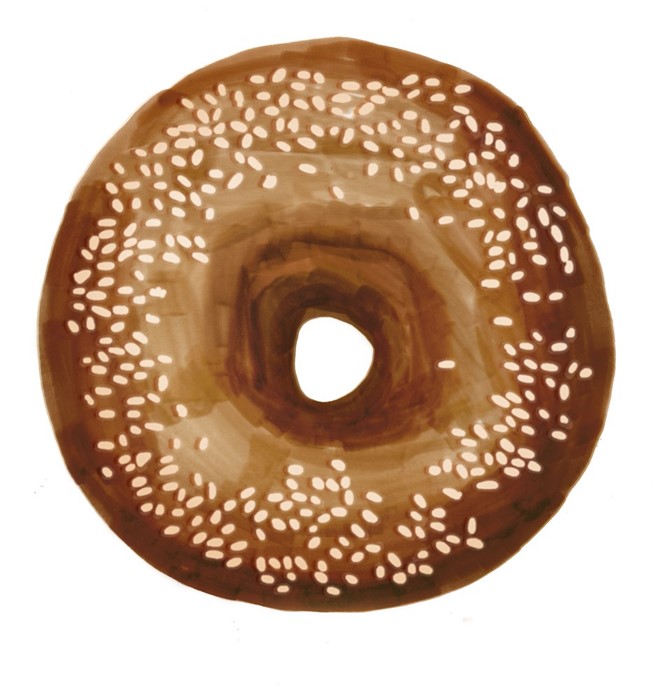As New York Fashion Week begins in earnest, AnOther presents the unwritten rules to eating that staple of American Jewish cuisine: the bagel
As synonymous with the city of New York as the Empire State Building or the Statue of Liberty, the bagel – that key representative of the joys of Jewish American cuisine – is a stalwart of the American diet. It ticks all the boxes: it’s refreshingly indiscriminate – there’s no stigma around eating one on the subway, say, and its comparatively low-calorie count (this is no dollar slice, people) makes for a happily malleable breakfast or mid-afternoon snack. The bagel is among the most compliant of baked goods, receptive as it is to all manner of variations: whether scattered with sesame seeds or sultanas, and made from white, wholewheat or cinnamon-dusted dough. Not to mention the obvious practical advantages of storing, transporting or displaying a foodstuff which, so conveniently, has a hole through its centre.
There is a reason that the bagel has become so indelibly and inextricably interwoven with New York City culture, and the key is in the water. American bagels, crucially, are boiled before baking, giving them the slightly crunchy, golden brown exterior which preserves the chewy, doughy centre. And in Manhattan and its surrounding boroughs, where the water supply is piped from upstate and therefore super low in both calcium and magnesium, the chemical reactions which occur during boiling and baking create the crunchy-on-the-outside and soft-on-the-inside effect better than anywhere else.

The History
The bagel arrived on New York's Lower East Side with the first Eastern European Jewish immigrants in the 1880s, diffusing across the city as the Jewish population grew, and was catalysed by the creation of Philadelphia cream cheese not long afterwards. Its original iteration, however, is largely unknown. One story which has proven particularly enduring cites King Jan Sobieski of 17th-century Poland as its honorary creator: as the legend goes, after the 1683 Battle of Vienna he became the first king to resist the decree which forbade those outside of the bakers’ guild from creating white bread, thereby allowing the Jewish population to bake to their heart’s desire.
As that same king saved Austria from Turkish invasion, one baker created a roll in the shape of his stirrup in his honour, naming it a ‘beugel’, or ‘stirrup’, and the bagel was born. Whole books have been written on the tales behind the bagel to illustrate the humble foodstuff’s defiant and proud status as a symbol of immigration – a rich and storied history which can only add to its flavour.
The Rules
They’re no longer sold stacked on long wooden dowels by Lower East Side street vendors, but there are a series of other defining factors which can help you identify a real New York bagel, the size being a key indicator. Where supermarket bought bagels are machine-made and comparatively heavy at a hefty seven ounces, the traditional predecessor weighs in at only three, and is hand-rolled before being left to rise for 12 or so hours for extra chewiness.

In the original iteration, there were only four flavours: plain, salted, poppyseed and sesame, but these days you can add anything from garlic and onion to blueberries to add an extra pop of flavour. For an authentic experience, try salt beef – a Jewish deli meat made of beef brisket cured in brine. The salty brine breaks down the meat’s toughness while allowing the rich flavour to circulate throughout it. Smoked salmon and cream cheese is similarly traditional, but purists should opt for lox, which is made from the rich, fatty and succulent belly of the fish, and salt-cured rather than smoked. Pay attention to the portions – too much of either salmon or cheese can ruin the taste of both – and if you are so inclined, add a few pickled capers for a mustard-like taste. Just don’t even consider adding a chocolate chip into the mix; purists will have you exiled immediately.
The mythology surrounding the correct way to prepare and eat a bagel is manifold, but one point is certain: they are not to be toasted. The reason? The perfect New York bagel should still be warm from the oven, and devouring it rapidly, without taking the time to slice it delicately into sections, will ensure that it stays so.
The One-Stop Shops
There’s hardly a native New Yorker in any of the five boroughs who doesn’t have an opinion on the best place to source bagels, but popular online opinion points to several suppliers whose exemplary skills set them far apart from the rabble. Established over a century ago in 1914, Russ & Daughters is a tried and tested Lower East Side institution, and neither its appearance nor its formulas have changed much in that time. Famously, the store counter is so long and narrow that servers are prohibited from slicing with their left hands, as it’s too dangerous in such a confined space. Its bagels are noticeably smaller than some might expect, and are selected for their ‘classical’ characteristics from The Bagel Hole in Brooklyn's Park Slope – so if you're so inclined, you can head straight to the source.
